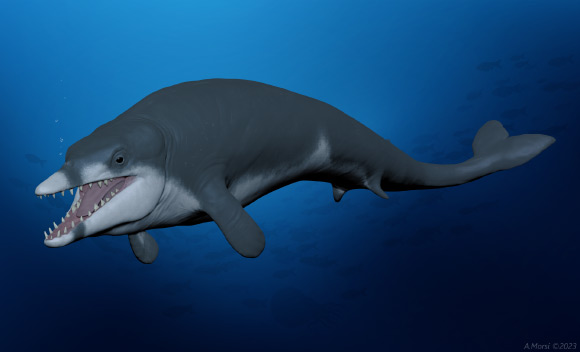The newly-identified species of basilosaurid whale has been named Tutcetus rayanensis after the ancient Egyptian pharaoh Tutankhamun. This new species is not only the smallest known basilosaurid, but it is also one of the oldest records of the family from Africa.

Life reconstruction of Tutcetus rayanensis swimming in the Tethys Ocean 41 million years ago. Image credit: Ahmed Morsi / Hesham Sallam / Mansoura University Vertebrate Paleontology Center.
Tutcetus rayanensis inhabited the Tethys Ocean approximately 41 million years ago.
The whale is the smallest basilosaurid known to date and is estimated to have been around 2.5 m (8 feet) in length and about 187 kg in body mass.
It is not only the smallest basilosaurid whale yet discovered, but it is also one of the oldest records worldwide.
“Basilosauridae, a group of extinct fully aquatic whales, represents a crucial stage in whale evolution, as they transitioned from land to sea,” said American University’s Professor Hesham Sallam and colleagues.
“They developed fish-like characteristics, such as a streamlined body, a strong tail, flippers, and a tail fin, and had the last hind limbs visible enough to be recognized as ‘legs,’ which were not used for walking but possibly for mating.”
“Whales’ evolution from land-dwelling animals to beautiful marine creatures embodies the marvelous adventurous journey of life,” Professor Sallam added.
“Tutcetus rayanensis is a remarkable discovery that documents one of the first phases of the transition to a fully aquatic lifestyle that took place in that journey.”

Photograph (a) and corresponding explanatory line drawing (b) of the block containing the holotype specimen of Tutcetus rayanensis. Image credit: Antar et al., doi: 10.1038/s42003-023-04986-w.
The fossilized skull, jaw, teeth and vertebrae of Tutcetus rayanensis were found in the Sath El-Hadid Formation of the Fayum Depression in Egypt.
The individual was near adulthood, but had not reached full adulthood, as the bones within its skull and vertebrae had fused together and its permanent teeth were at an advanced stage of emergence — with its permanent molars having emerged before its anterior premolars, incisors, and canines.
The paleontologists speculate that the smaller body size of Tutcetus rayanensis, compared to other basilosaurids, may have evolved in response to a warming event — known as the Lutetian thermal maximum — that occurred around 42 million years ago.
“Modern whales migrate to warmer, shallow waters for breeding and reproduction, mirroring the conditions found in Egypt 41 million years ago,” said Abdullah Gohar, a Ph.D. student at Mansoura University.
“This supports the idea that what is known as now Fayum was a crucial breeding area for ancient whales, possibly attracting them from various locations and, in turn, drawing in larger predatory whales like Basilosaurus.”
The findings have significant paleobiogeographic implications, demonstrating that basilosaurids likely achieved a rapid spread over the southern hemisphere, reaching high latitudes by the Middle Eocene.
“The Eocene fossil sites of Egypt’s Western Desert have long been the world’s most important for understanding the early evolution of whales and their transition to a fully aquatic existence,” said University of Southern California’s Professor Erik Seiffert.
“The discovery of Tutcetus rayanensis demonstrates that this region still has so much more to tell us about the fascinating story of whale evolution.”
The team’s paper was published in the journal Communications Biology.
_____
M.S. Antar et al. 2023. A diminutive new basilosaurid whale reveals the trajectory of the cetacean life histories during the Eocene. Commun Biol 6, 707; doi: 10.1038/s42003-023-04986-w







